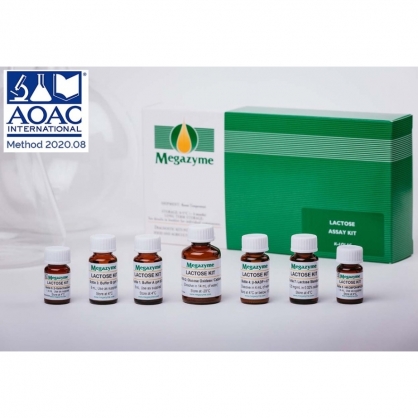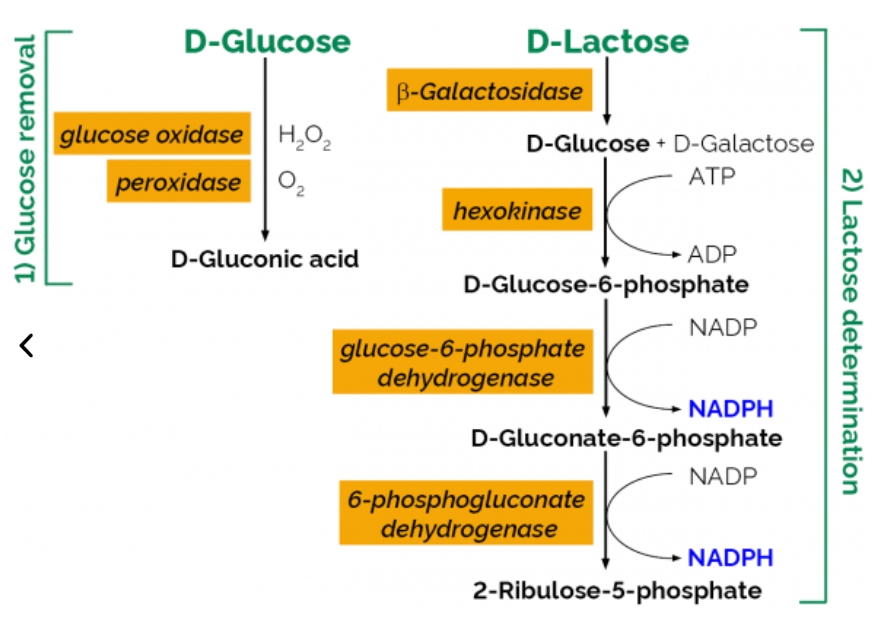- 背景資料
乳糖(Lactose)為一種雙醣,由一分子的半乳糖和一分子的葡萄糖以ꞵ(1,4)糖苷鍵鍵結而成,乳糖的食物來源主要以乳製品為主。近年來因為「乳糖不耐症」的因素,進而使市場推出了低乳糖(low-lactose)或無乳糖(lactose-free)的產品,以此滿足消費者的需求。在食品工業上為了去除乳製品中的乳糖,會利用β-半乳糖苷酶(β-galactosidase)將乳糖水解成一分子的半乳糖和一分子的葡萄糖,但此時β-半乳糖苷酶亦會表現出轉半乳糖活性(transgalactosylation)(轉移醣苷化作用)(轉醣反應)(醣轉反應)(酵素半乳糖複合物與各種醣類結合),進而生合成出一些寡糖類物質,此類寡糖物質被稱為半乳寡糖(galacto-oligosaccharides ,簡稱GOS)。
半乳寡糖(galacto-oligosaccharides ,簡稱GOS),為一種益生元(prebiotic),其結構上由數個半乳糖以β構型鍵結形成,聚合度(Degree of polymeration, DP)為二至八,因β-半乳糖苷酶來源、半乳寡糖的聚合度、鍵結方式、位置..等差異性,故會產生諸多種類之鍵結異構物(Linkage isomers)。此外,在食品工業上常利用高濃度乳糖為基質,並以β-半乳糖苷酶進行轉醣反應來大量生產半乳寡糖 。
在低乳糖或無乳糖的乳製品中,因加入β-半乳糖苷酶(轉醣反應),故產品中亦會產生多種半乳寡糖(例如:allolactose),其半乳寡糖含量可能與產品中乳糖含量相當或更多。因此,低乳糖或無乳糖的乳製品在乳糖含量之檢測上較為困難。
- Standard assay procedure for low-lactose or lactose-free milk
NOTE: Sample volumes in Section C must not exceed 0.4 mL because at higher levels, free D-galactose in the sample inhibits the β-galactosidase. For samples other than low-lactose or lactose-free milk, refer to “Sample Preparation” sections on pages 14 and 15.
A. Sample preparation
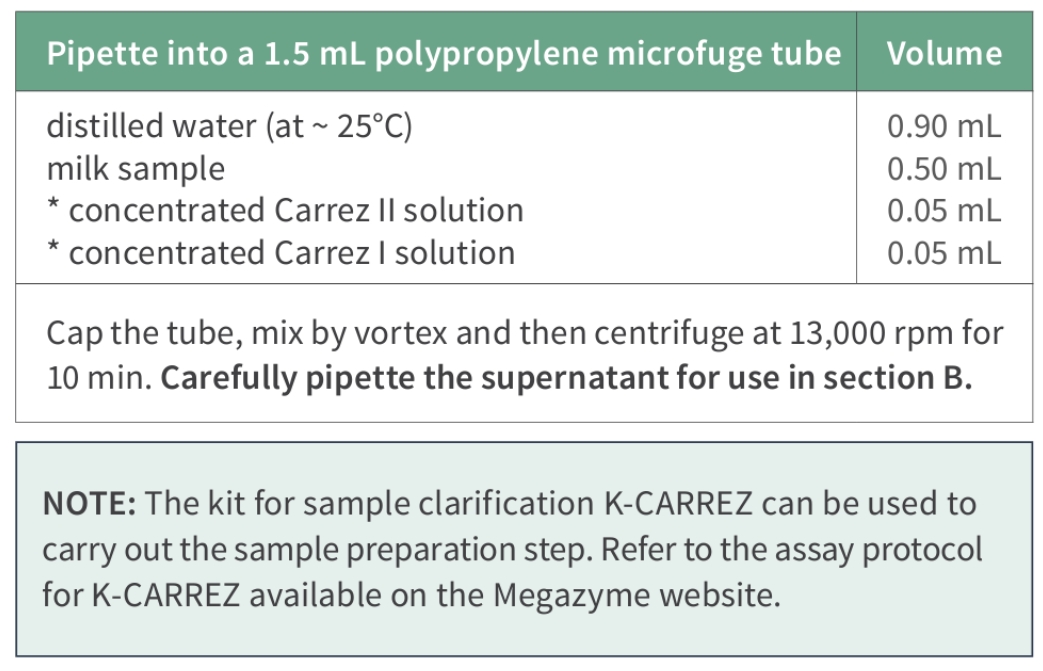
B. Glucose oxidase/catalase pre-treatment

NOTE: If the recommended centrifuge able to reach 13,000 rpm is not available, filtration using Whatman Type I (or equivalent) filter paper or using a syringe filter is also a possibility. Please refer to the relevant FAQ on the Megazyme website (www.megazyme.com).
C. Enzymatic determination reaction
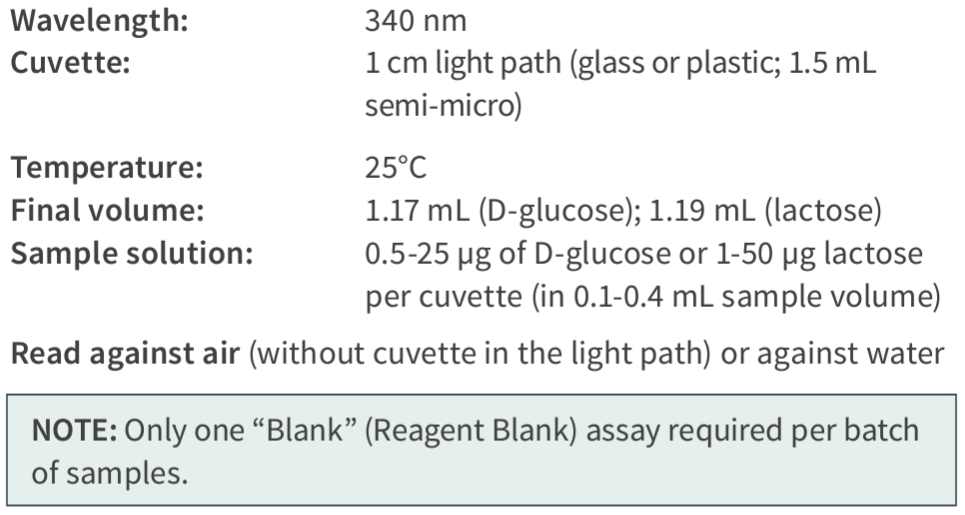
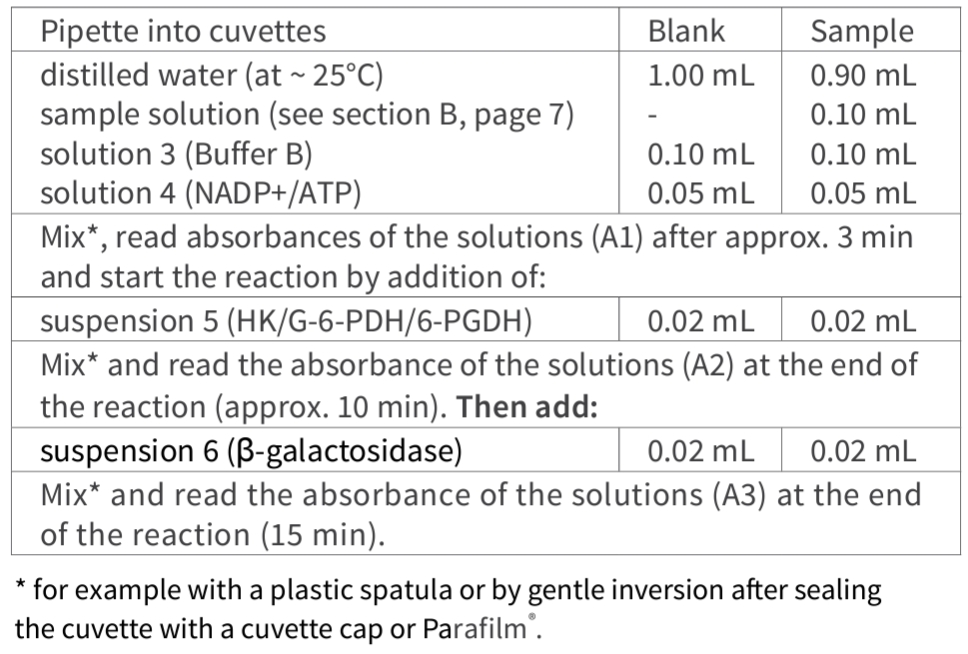
NOTE: For low-lactose and lactose-free samples, continue to read the absorbance value exactly at 5 min intervals after the 15 min reaction. Take readings at exactly 20 min and 25 min after the addition of suspension 6. Input the absorbance readings into the “Creep Calculator” tab on the Megazyme Mega-CalcTM, downloadable from the Megazyme website. Using this calculator allows more accurate measurement of just lactose and removes some GOS interference.
NOTE: For “low-lactose” and “lactose-free” samples, where a sample has generated absorbance differences (A2-A1) > 0.300 or (A3-A2) > 1.500 refer to “Troubleshooting” on page 14.
- A. Troubleshooting
Samples with (A2-A1 ) above 0.300 or (A3-A2 ) above 1.500:
Recommendations for re-processing samples that have generated absorbance differences (A2-A1 ) above 0.300 or (A3-A2 ) above 1.500 when processed using the Standard Assay Procedure (section A, B and C, pages 8 and 9) are given in the table below. The suggested recommendations are dependent upon the combination of the two absorbance values generated:
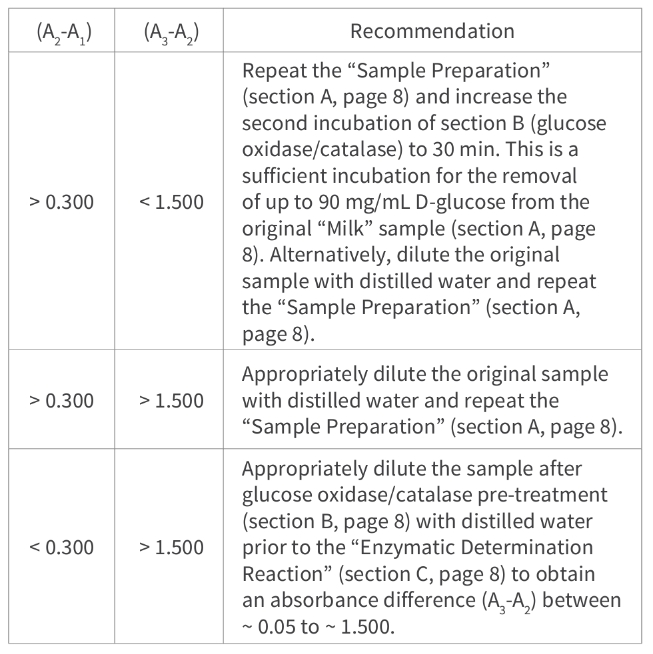
- B. Sample preparation
1. Sample dilution.
Dilution Table
The amount of lactose present in the cuvette should range between 1 and 50 μg (or between 0.5 and 25 μg for D-glucose), i.e. in the 0.1 mL of sample being analysed. The sample solution must therefore be diluted sufficiently to yield a lactose concentration between 0.01 and 0.50 g/L (or between 0.005 and 0.25 g/L for D-glucose).
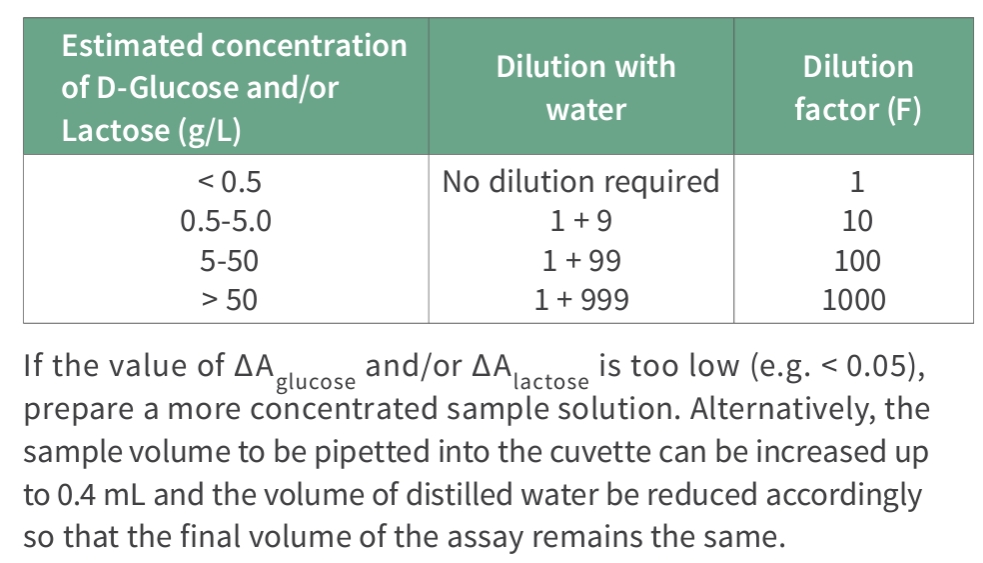
2. General considerations.
(a) Liquid samples: clear, slightly coloured and approximately neutral, liquid samples can be used directly in the assay.
(b) Acidic samples: if > 0.1 mL of an acidic sample is to be used undiluted, the pH of the solution should be increased to approx. 7.6 using 2 M NaOH, and the solution incubated at room temperature for 30 min.
(c) Carbon dioxide: samples containing a significant amount of carbon dioxide should be degassed by increasing the pH to approx. 7.6 with 2 M NaOH and gentle stirring, or by stirring with a glass rod.
(d) Coloured samples: an additional sample blank, i.e. sample with no β-galactosidase, may be necessary in the case of coloured samples.
(e) Strongly coloured samples: if used undiluted, strongly coloured samples should be treated by the addition of 0.2 g of polyvinylpolypyrrolidone (PVPP)/10 mL of sample. Shake the tube vigorously for 5 min and then filter through Whatman No. 1 filter paper.
(f) Solid samples: homogenise or crush solid samples in distilled water and filter if necessary.
商品特色
商品規格
- 商品規格 65 檢測反應
Bottle 1:
Buffer A (8 mL, pH 8.0) plus sodium azide (0.02% w/v) as a preservative.
Stable for > 2 years at 4°C.
Bottle 2:
Glucose oxidase (GOX) and catalase, lyophilised powder.
Stable for > 2 years below -10°C.
Bottle 3:
Buffer B (8 mL, pH 7.6) plus sodium azide (0.02% w/v) as a preservative.
Stable for > 2 years at 4°C.
Bottle 4:
NADP+ plus ATP.
Stable for > 5 years below -10°C.
Bottle 5:
Hexokinase plus glucose-6-phosphate dehydrogenase plus 6-phosphogluconate dehydrogenase suspension (1.4 mL).
Stable for > 2 years at 4°C.
Bottle 6:
MZ104 β-galactosidase suspension (1.4 mL).
Stable for > 2 years at 4°C.
Bottle 7:
Lactose standard solution (5 mL, 0.25 mg/mL in 0.02% w/v sodium azide)
Stable for > 2 years; store sealed at 4°C.
